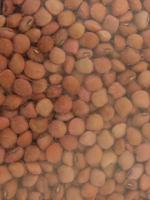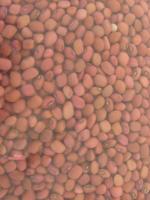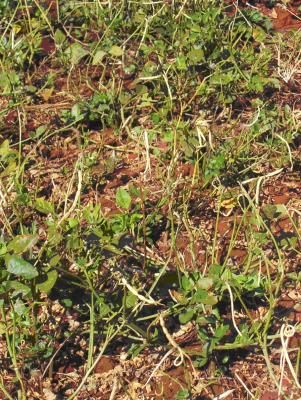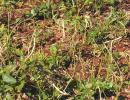
|
Cowpea
Scientific name:
Vigna unguiculata
Order/Family:
Fabales: Fabaceae
Local names:
Kunde (Swahili, Kipsigis), mathoroko (Kikuyu), likhuvi (Luhya),a lot-bo (Luo), nthooko (Kamba), egesare (Kisii), Kiyindiru (Luganda)
Common names:
yard long bean
Pests and Diseases:
African bollworm
Anthracnose
Aphids
Bacterial blight
Brown blotch
Bugs
Charcoal rot
Cowpea mosaic diseases
Cowpea seed beetle
Damping-off diseases
Flower or blister beetles
Foliage beetles
Fusarium wilt
Leaf spots
Legume pod borer
Powdery mildew
Purple witchweed
Root-knot nematodes
Rust
Southern blight
Storage pests
Thrips
Bean fly, Whiteflies
|
African bollworm (Helicoverpa armigera)
The African bollworm caterpillars are 3 to 4 cm long. Several leaf-eating caterpillars feed on cowpeas. Several species of Spodoptera are sporadic cowpea pests. The hairy caterpillar Amsacta moorei causes extensive damage to seedlings and it has been considered the most important pests of cowpeas in Senegal. African bollworm (Helicoverpa armigera) can cause extensive damage on young pods. Natural enemies are important to keep pest populations at low level.
- Monitor regularly for caterpillar eggs and just emerging caterpillars.
- Hand pick eggs and young caterpillars. This helps when their numbers are low and in small fields.
- Use of bio-pesticides such as botanicals (e. g. neem extracts) and Bt. For more information on neem click here. For information on Bt click here
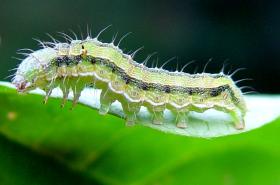
© A.M. Varela, icipe
Anthracnose (Colletotrichum lindemuthanium)
This is a major cowpea disease, which can be very severe in areas where cowpeas are grown as the sole crop. Stems affected by anthracnose exhibit dark brown areas that later join up to cover the entire stem as well as branches, peduncles and petioles. The disease also attacks the pods.
Lesions on pods are sunken and brownish and under wet conditions they are covered with a pink fungal spore mass. Under severe infection, stems die. The disease attacks all legumes. Anthracnose is most prevalent during warm, humid weather. It is transmitted through infected seeds and survives in crop debris.
- Plant resistant varieties, if available.
- Use certified disease-free seeds.
- Practise good field sanitation.
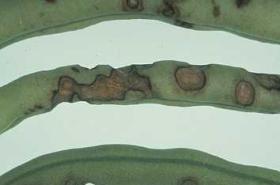
© Denis Persley/Tony Cooke, (www.ecoport.org)

Anthracnos…

Anthracnos…

Anthracnos…
The legume aphid (Aphis craccivora)
It is a widespread pest of cowpeas. Aphids suck sap on stems, terminal shoots and petioles of seedlings, and on pods and flowers of mature plants.
A heavy attack can cause death of young seedlings, stunting and delay in flowering on older plants. However, it is more important as vector of virus diseases (e.g. the cowpea mosaic virus).
- Use resistant varieties where available.
- Monitor build-up of aphids and natural enemies.
- Use neem seed or leaf extracts if necessary.
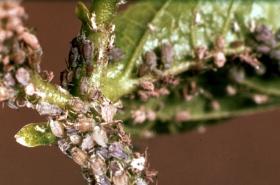
© Clemson University - USDA Cooperative Extension Slide Series, Bugwood.org

Black legu…

Aphids
Bacterial blight (Xanthomonas axonopodis pv. vignicola)
This disease appears as tan to brown angular leaf spots with yellow margins on leaves, pods, and stems. It may cause severe defoliation during periods of high humidity. It is seed-borne.
- Use certified disease-free seeds.
- Avoid working in the fields when it is wet.
- Practise good field sanitation.
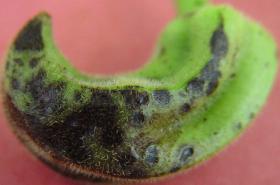
© A.A. Seif & A.M. Varela, icipe

Bacterial …

Bacterial …
Brown blotch (Colletotrichum truncatum)
The fungus causes pre-emergence and post-emergence damping off when infected seeds are planted. The former rots the seed before emergence from the soil while post-emergence kills the seedlings after emergence. The disease also attacks the foliage, stems and pods. Sunken, oval spots may be seen on stems; circular spots on leaves. Lesions are reddish-brown. Under prolonged wet weather heavy defoliation occurs. During late reproductive stages, infected tissues are covered with black fungal fruiting bodies, which produce minute black spines (setae) that can be seen with the unaided eye. It is transmitted through infected seeds and survives in crop debris.
- Use certified disease-free seeds.
- Use resistant varieties where available.
- Practise good field sanitation.
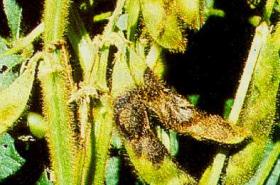
© Tadashi Yorinori J. (Courtesy of EcoPort, www.ecoport.org)
Bugs
There are several pod sucking bugs. The tip wilter (Anoplocnemis curvipes), the spiny brown bug (Clavigralla tomentosicollis, Riptortus bugs (Riptortus dentipes), Mirperus jaculus, the green stink bug (Nezara viridula) and Aspavia sp.
These bugs attack cowpeas in Africa. The spiny brown bug Clavigralla tomentosicollis and Riptortus dentipes are the most important, causing serious damage. Nymphs and adults attack young, tender pods and causing shrivelling and rotting of pods and malformation of seeds, which lose viability.
Bugs are difficult to control since they usually feed on a wide range of crops and are very mobile.
- Control weeds to destroy roosting sites.
- Monitor crops regularly. A threshold of 2 bugs/metre row has been recommended as a guideline for bug control in Ghana (GTZ/PPRSD).
- Conserve natural enemies such as assassin bugs, spiders, praying mantises and ants. These are important natural enemies of bugs. They kill or deter bugs. Conserve and attract predatory natural enemies to your crop by planting flowering plants. For more information on natural enemies click here
- A number of plants (lantana, garlic, oleander, African marigold, blackjack, goat weed, wormseed, among others) are reported as effective repellent crops against various species of bugs (Elwell and Maas, 1995).
- Alghali (1991) reported an integrated pest management strategy for cowpea production. In Nigeria, intercropping with sorghum reduced the numbers of Riptortus bugs in cowpea significantly.
- Bugs can be collected by hand regularly and killed, especially during flowering and pod formation.
- A commercial formulation of neem (Neemix®) gave effective control of stink bugs on cowpeas. This product was applied three times at the beginning at pod formation using 210 g azadirachtin per hectare (Abudulai et al., 2003).
- Pyrethrins are recommended for control of sucking bugs in organic production in USA (Layton, 2004).
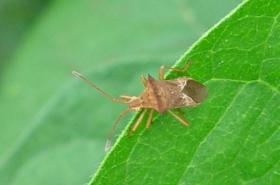
© A.M. Varela, icipe

Spiny brow…

Riptortus …
Charcoal rot (Macrophomina phaseolina)
Charcoal Rot (fungus - Macrophomina phaseolina). Many plants are susceptible to this soil borne fungus and symptoms vary according to type. Infected stem tissue shows evidence of shredding with tiny black dots (sclerotia) between the remaining tissues. This gives those plant parts an ashy-grey appearance. This can be observed by splitting the stalk and noting the deteriorated soft pith tissue leaving the tougher vascular strands. Fungal structures (sclerotia) can be observed in the affected tissue which appears as though it has been dusted with black pepper
Charcoal rot occurs most consistently when plants are experiencing moisture stress due to drought. The fungus is widely distributed and builds up in soil when susceptible host plants are present and conditions favour its development.
Avoiding moisture stress, proper management of crop residue, crop rotation, avoiding excessive plant populations, balancing nitrogen and potassium fertility levels, and growing drought-tolerant, lodging-resistant hybrids represent the best means of control.
- Rotate with unrelated crops (e.g. cereals) helps reduce the population of the fungus in the soil.
- Avoid moisture stress by increasing the moisture holding capacity of the soil and, if available, using irrigation when needed.
- Practices that hasten decomposition of crop residue may help decrease the population of the fungus in the soil.
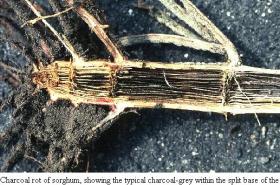
© Joseph Krausz, Texas Agricultural Extension Service
Cowpea mosaic diseases
These viruses produce a mosaic pattern on cowpeas. They may be found singularly or in combination with others. They cause irregular light and dark green mosaic patterns on the leaves. Some viruses cause thickened, malformed leaves. The mosaic patterns are best observed on the younger foliage. Plants may be stunted and fail to produce normal pods. If the disease attacks plants at the early growth stage, no pods should be expected.
The most common virus disease on cowpeas is cowpea aphid-borne mosaic potyvirus. It is transmitted by aphids.
Mosaic diseases include:
- Cowpea mosaic comovirus (CpMV)
- Blackeye cowpea mosaic potyvirus (BICMV)
- Cowpea severe mosaic virus (CPSMV)
- Cowpea aphid-borne mosaic potyvirus (CAMV)
- Cowpea mottle carmovirus (CPMoV)
- Cowpea golden mosaic bigeminivirus.
- Plant resistant varieties, where available.
- Use healthy, disease-free seeds rather than saving seed from a crop that could be infected.
- Practise crop rotation with non-legumes (e.g. cereals).
- Remove alternative hosts of virus diseases (legumes).
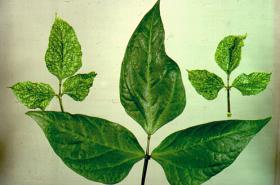
© Thorben Lundsgaard, KVL, Denmark
Cowpea weevils (Callosobruchus spp.)
Adults are 2.0-3.5 mm long. They are also known as the cowpea seed beetles and are the principal storage pest of cowpea. These bruchids may infest up to 100% of the stored seeds within 3 to 6 months under ordinary storage conditions. A positive relationship between pod damage by field pest (pod sucking bugs and pod borers) and bruchid infestation in storage was found in Uganda. Controlling pests infesting pods of cowpeas in the field significantly reduce bruchid carryover in storage (IPM CRSP).
- Use neem extracts.
- Dry seeds for storage to a moisture level below 13%.
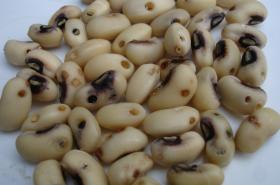
© A. M. Varela, icipe

Cowpea wee…

Cowpea see…

Cowpea see…
Damping-off diseases (Rhizoctonia sp., Phythium sp., Fusarium sp.)
Seeds may rot before emergence from the soil and young seedlings may die. The condition is most common on early plantings or when soil contains a large amount of undecomposed plant residue.
Damping-off diseases are favoured by cool, wet soil conditions.
- Avoid planting in wet, cold soils.
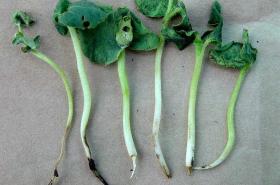
© A.A. Seif & A.M. Varela, icipe

Damping-of…

Damping-of…
Flower or blister beetles (Mylabris spp. and Coryna spp.)
These beetles can cause serious damage to cowpeas by feeding on flowers. The adults of the flower beetles, also known as blister beetles, feed on flowers (petals and / or pollen) reducing pod set.
The adults are medium to large sized beetles (2-5cm in length), usually black and yellow or black and red in colour. The immature stages (larvae) do not feed on plants. They live in he soil and eat grasshopper eggs.
- Hand pick and destroy adult beetles to keep the numbers in check. However, care should be taken, since when disturbed, blister beetles can release a liquid that burn the skin. Whenever possible wear gloves to protect the hands.
- Do not destroy the larvae, as they are beneficial (they feed on grasshopper eggs).
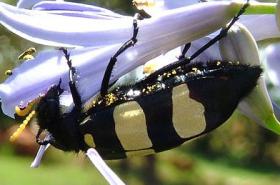
© Botha AD (Courtesy of EcoPort, www.ecoport.org)
Cowpea wilt (Fusarium oxysporum f. sp. tracheiphilum)
Cowpea wilt (Fusarium oxysporum f. sp. tracheiphilum)
Fusarium wilt usually causes the lower leaves on one side of the plant to turn yellow. Infected plants usually are stunted and wilted as the organism develops in the food and water conducting tissues. Brick red tissue can be observed in the stem when it is split lengthwise.
- Use resistant varieties, if available.
- Control root-knot nematodes since nematodes increase plant susceptibility to Fusarium wilt.
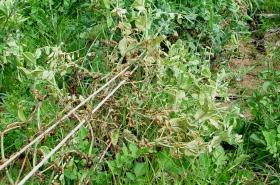
© A.M. Varela, icipe

Fusarium w…

Fusarium w…

Fusarium w…
Leaf spots (Cercospora sp., Aristastoma sp., Ascochyta sp., Colletotrichum sp., Stagnospora sp.)
Leaf spots are various sized often yellowish in colour or with a yellow halo, others brown to purplish; These normally develop first on lower leaves. With Cercospora leaf spot a dark, mouldy growth develops on the lower leaf surface corresponding to the spot. Leafspot diseases are most serious during periods of prolonged moist weather and on late plantings. Severe leaf spotting results in defoliation with subsequent yield reductions.
- Use certified disease-free seeds.
- Practise crop rotation with non-legumes (e.g. cereals).
- Avoid cultivating fields when foliage is wet.
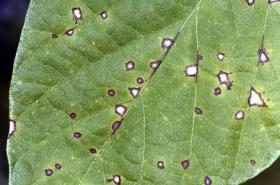
© Clemson University, USDA (EcoPort, www.ecoport.org)
Legume pod borer (Maruca vitrata)
This is the most important pod borer pest, causing severe damage to cowpeas. Losses over 80% have been reported on indigenous varieties and even on high yielding varieties.
Moths usually lay eggs on flower buds, flowers, or on terminal shoots of young plants. Young caterpillars may feed on any part of the flowers or foliage. Several young caterpillars may be found together among flowers. Older caterpillars are highly mobile, feeding continuously on flowers and newly formed pods, causing severe damage to the crop. Upon reaching maturity the caterpillars drop from flowers or pods onto the soil and pupate beneath the plant under leaf debris.
Caterpillars of the legume pod borer are dull to yellow-white and often reach a length of 1.8 cm. Each segment has dark spots that form a distinct series along the length of the body. The head is dark brown to black.
- In Ghana, spraying with neem extracts and use of the trap crop Crotalaria juncea has been recommended (GTZ/PPRSD). Neem products showed to be effective against the legume pod borer in Niger. Weekly applications of an aqueous neem seed extract proved to be more effective than neem oil at 12l/ha (Dreyer and Ostermann, 1995).
- Leaf and bark extracts of the forest trees Khaya anthotheca and K. grandifolia proved to have the same insecticidal and anti-feedant properties like neem on the legume pod borer in West Africa (IITA).
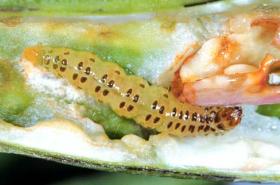
© Ooi P. Courtesy of EcoPort, www.ecoport.org
Powdery mildew (Erysiphe polygoni)
Symptoms consist of a light, greyish, powdery growth on the leaves, pods and occasionally the stems. This powdery growth is easily rubbed off. When the disease is severe, plants turn yellow and defoliate. Generally, powdery mildew does not damage early-planted cowpeas. It can, however, be quite destructive on a late-planted crop. A fairly dry soil and heavy application of nitrogen-based fertiliser tend to increase disease severity.
- Plant resistant varieties where available.
- Practise good field sanitation.
- Avoid close planting.
- Control weeds.
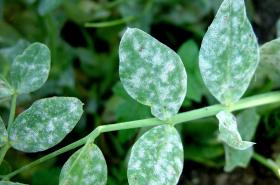
© A. M. Varela, icipe
Witchweed (Striga hermonthica)
The parasitic weed witchweed (Striga gesnerioides) is also a problem in cowpea.
- Practise crop rotation.
- Practise fallow.
- Use resistant cultivars if available.
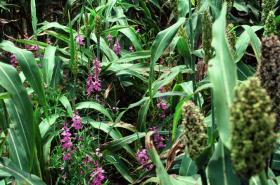
© USDA APHIS Archives, www.insectimages.org
Root-knot nematodes (Meloidogyne spp.)
Relatively small galls or knots develop on roots of affected plants. Do not confuse root knot galls with naturally occurring bacterial nodules that are beneficial.
- Use resistant or tolerant varieties if available.
- After harvest, uproot entire plants and destroy crop debris. Tops can be composted but any infested roots should be burnt since nematodes may survive the relatively low heat of compost heap.
- Flooding the soil for a few weeks will reduce nematode populations, as will bare fallow.
- Use mixed cropping or grow African marigolds (Tagetes spp.). These have nematicidal properties that will help to reduce nematode populations.
- Rotate with nematode resistant or tolerant crops (e.g. cereals, onions or fodder grasses).
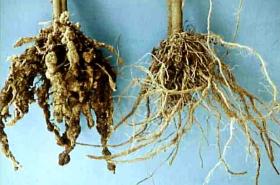
© A. M. Varela, icipe
Rust (Uromyces vignae)
Small, reddish-brown pustules (blisters) appear on both upper and lower leaf surfaces. Rust can develop rapidly, resulting in severe leaf damage and defoliation.
- Use sulfur based products or potassium carbonate. Do not spray sulphur when it is hot, as it can burn the foliage and flowers.
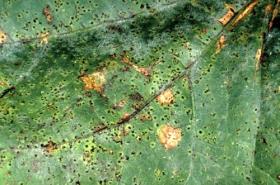
© Jackson G. (Courtesy of EcoPort, www.ecoport.org)
Southern blight (Sclerotium rolfsii)
It attacks roots and stems of cowpeas. The first visible symptom of southern blight is a progressive, yellowing and wilting of the foliage beginning on the lower leaves. The plant dies within a few days after the first symptoms appear. During warm, moist conditions, the coarse, white mycelium of the fungus makes characteristic fan-shaped patterns of growth on the stem at the soil line. In this white mat of the fungus, numerous smooth, round, light-tan to dark-brown mustard seed-like bodies called sclerotia are formed.
- Practise good field sanitation.
- Practise crop rotation with non-legumes.
- Plough the soil deep.

© Clemson University - USDA Cooperative Extension Slide Series, www.insectimages.org\n
Storage pests
The pod weevil (Piezotrachelus varius or Apion varium). Its a common pest of cowpeas in West Africa. Generally 13-26% of the pods are damaged. Losses of seeds up to 92% have been reported in Nigeria. The shiny black weevils bore holes in fresh green cowpea pods and lay eggs into the pods. The grubs feed on the seeds and pupate within the pods.
- No information on control (other than pesticides) available
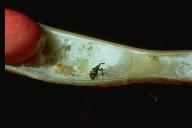
© Frank Peairs, Colorado State University
Thrips (Megalurothrips sjostedti and Frankliniella schultzei)
Thrips are among the most widespread and important pests of cowpeas in Africa. The cowpea flower thrips or African bean flower thrips (Megalurothrips sjostedti) causes yield losses of up to 100%.
During the pre-flowering period, nymphs and adults of this thrips may damage the terminal buds. However, the main damage is on the flower buds and flowers. Attacked flower buds become brown and eventually fall off, leaving behind dark red scares. Damaged flowers are distorted, malformed and show decolouration and may fall off. Infested on pods are malformed.
- Intercropping: There are several reports that thrips populations are reduced when cowpeas are intercropped with maize or sorghum. However, there are also conflicting reports (Ezueh, 1991) indicating increased pod borer and pod sucking bug populations in mixed cropping of cowpeas with sorghum (Nanpala et al, 2002).
In Kenya, populations of the African bean flower thrips (Megalurothips sjostedti) and Hydatothrips adolfifriderici on cowpea buds were almost halved by intercropping the cowpea with sorghum and maize (Parella and Lewis, 1997). - Use resistant varieties. The varieties "IT90K-277-2", "KVx404-8-1", "Moussa Local", "Sanzisabinli", "Sewe", "TVu1509", "TVx34236", and "IT91K-180" are reported to show resistance against the cowpea flower thrips in West Africa (IITA).
- Spraying with neem extracts. In Ghana a threshold of 5 thrips per flower is recommended as a guideline before spraying (GTZ/PPRSD). In Uganda the economic injury level has been established at 7 thrips per flower (IPM CRSP).
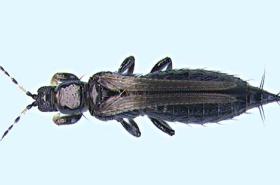
© Georg Goergen (Courtesy of EcoPort, www.ecoport.org)

Flower thr…

Thrips dam…
| General Information and Agronomic Aspects | Information on Weeds | |||
| Information on Pests | Information Source Links | |||
| Information on Diseases | Contacts for cowpea seeds: |
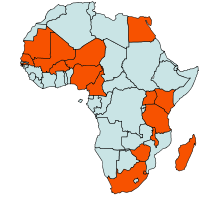 |
| Geographical Distribution of Cowpea in Africa |
Cowpeas are mainly important in the marginal rainfall areas because they are well adapted to dry climate and suitable for a variety of intercropping systems. Cowpeas are cultivated for the seeds (shelled green or dried), the pods or leaves that are consumed as green vegetables or for pasture, hay, silage and green manure. Tender cowpea leaves and shoots contain 4% protein, 4% carbohydrates and are rich in calcium, phosphorus and vitamin B.
Dried seeds contain 22% protein and 61% carbohydrates. The leaves may be dried and stored for later use. Cowpeas that are sprayed with pesticides should not be eaten as leaves unless pre-harvest intervals are followed. In Africa, where cowpeas are the preferred food legume, they are consumed in three basic forms:
- Cooked together with vegetables, spices and often palm oil, to produce a thick bean soup, which accompanies the staple food (cassava, yams, plantain)
- Decorticated and ground into a flour and mixed with chopped onions and spices and made into cakes that are either deep-fried (akara balls)
- Steamed (moin-moin)
Nutritive Value per 100 g of edible Portion
| Raw or Cooked Cowpea | Food Energy (Calories / %Daily Value*) |
Carbohydrates (g / %DV) |
Fat (g / %DV) |
Protein (g / %DV) |
Calcium (g / %DV) |
Phosphorus (mg / %DV) |
Iron (mg / %DV) |
Potassium (mg / %DV) |
Vitamin A (I.U) |
Vitamin C (I.U) |
Vitamin B 6 (I.U) |
Vitamin B 12 (I.U) |
Thiamine (mg / %DV) |
Riboflavin (mg / %DV) |
Ash (g / %DV) |
| Cowpeas cooked | 117 / 6% | 20.3 / 7% | 0.7 / 1% | 8.1 / 16% | 26.0 / 3% | 142.0 / 14% | 3.0 / 17% | 375 / 11% | 10 IU / 0% | 0.4 / 1% | 0.1 / 5% | 0.0 / 0% | 0.2 / 11% | 0.0 / 3% | 1.2 |
| Cowpeas raw | 343 / 17% | 59.6 / 20% | 2.1 / 3% | 23.9 / 48% | 85.0 / 9% | 438 / 44% | 9.9 / 55% | 1375 / 39% | 33.0 IU / 1% | 1.5 / 2% | 0.4 / 18% | 0.0 / 0% | 0.7 / 45% | 0.2 / 10% | 3.4 |
Cowpea varieties and their characteristics:
| Variety | Maturity Days | Target areas of production | Potential grain yield (t/ha) | Remarks | |||
"Machachos 66" (M66)
|
85-95 | Medium and higher altitudes 1200-1500m above sea level | 1.5-1.8 | Dual purpose; creamy brown grains and good for intercropping; tolerant to cowpea yellow mosaic virus (CYMV) and scab; moderately tolerant to Septoria leaf spot and powdery mildew | |||
"Katumani 80" (K80)
|
75-85 | Drier areas or areas below 1500m above sea level receiving less than 200mm rain per season | 1.8-2.0 | Dual purpose; grains creamy brown; resistant to aphids; moderately tolerant to thrips, pod borers and leaf hoppers; susceptible to CYMV | |||
"KVU 27-1"
|
70-90 | 600-1200m | 1.5-1.8 | Dual purpose; dark red grains; moderately tolerant to aphids, thrips, pod borers and leaf hoppers; moderately resistant to foliar fungal diseases and CYMV | |||
| "KVU-419" | 65-72 | Areas below 1200m receiving less than 200mm rain per season | 1.2-1.5 | Grain variety; smaller seed than both "M66" and "K80"; tolerant to cold and recovers very fast from drought | |||
| "KVU HB 48E 10" | 85-95 | Medium and higher altitudes 1200-1500m above sea level | 1.2-1.4 | More vegetable type than grain type; tolerant to virus diseases | |||
| "KCP 022" | 60-75 | 0-1200m | 1.2-1.5 | Drought tolerant | |||
| "MTW 63" | 60 | 1-1500 m | 2.5 | Pest tolerant | |||
| "MTW 610" | 60 | 1-1500m | 2.5 | Large grains | |||
| "Kunde 1" | 75-90 | Below 2000m | 1.2-2.5 | Dual purpose | |||
| "ICV" | 75 | 1-1500m | 2.2 | Pest tolerant | |||
| "Ngombe" | Semi spreading, good for green leaf production, sweet taste of grain | ||||||
| Local varieties (land races) |
0.3-0.5 | Varying colours and spreading or semi spreading |
Examples of cowpea varieties in Tanzania
- "Fahari" (altitude recommended: 0-1500 m; days to flowering: 50; grain yellowish brown; grain yield: 2.4 t/ha; resistant to CYMV
- "Tumaini" (altitude recommended: 0-1500 m; days to flowering: 48; grain cream; grain yield: 2.4 t/ha; resistant to CYMV and moderately resist to bacterial blight
- "Vuli 1" (altitude recommended: 0-1500 m; grain red; grain yield:1.8-2.0 t/ha; resistant to CYMV and moderately resist to bacterial blight
- "Vuli 2" (altitude recommended: below 1500 m; grain creamish white; grain yield: 2.0-2.5 t/ha; resistant to CYMV and bacterial blight; moderately susceptible to pests
Examples of cowpea varieties in Uganda
- "Amul" (local variety: regions: eastern and northern districts of Uganda; yield potential; 0.5 t/ha)
- "Apei" (local variety: regions: eastern and northern districts of Uganda; yield potential; 0.5 t/ha)
- "Apio" (local variety: regions: eastern and northern districts of Uganda; yield potential; 0.5 t/ha)
- "Ebelat" (local variety: regions: eastern and northern districts of Uganda; yield potential; 0.5 t/ha)
- "Icinkukwa" (local variety: regions: eastern and northern districts of Uganda; yield potential; 0.5 t/ha)
- "Katumani 80" (as in Kenya)
- "Kisyanka" (local variety: regions: eastern and northern districts of Uganda; yield potential; 0.5 t/ha)
- "IT82D-522-1" (improved variety; yield potential: 4.5 t/ha)
- "IT85F-1987" (improved variety: yield potential: 2.1 t/ha)
One additional benefit of cultivating cowpeas is their ability to fix atmospheric nitrogen in root nodules through symbiosis with Rhizobium bacteria that are common in most soils. An effective cowpea-Rhizobium symbiosis fixes more than 150 kg/ha of N and supplies 80-90% of the total N required. Inoculation may be advantageous, if the crop has not been grown for many years. In general, no fertilisers are applied. Cowpeas are commonly incorporated in crop rotations in semi-arid, humid and subhumid environments.
A cowpea crop of the leafy types grown before a maize or millet crop and incorporated green into the soil, can produce a good grain crop without any addition of more nitrogen. Intercropped cowpeas also share nitrogen with the other crops e.g. maize, millet, sorghum and cotton). For intercropping choose a cowpea variety carefully - the spreading types may over power other crops such as cotton by entangling their branches and interfering with fieldwork.
Cowpeas do not normally respond to nitrogen or phosphorus fertilisers, so none need adding. However where soils are highly eroded an application of 5 tons/ha of dry compost or manure is beneficial.
Weed during early stages of crop, later the cowpeas will cover the ground and suppress weeds including purple witchweeds. Two weedings are recommended, one two weeks after emergence and the second weeding just before flowering.
|
African bollworm (Helicoverpa armigera) The African bollworm caterpillars are 3 to 4 cm long. Several leaf-eating caterpillars feed on cowpeas. Several species of Spodoptera are sporadic cowpea pests. The hairy caterpillar Amsacta moorei causes extensive damage to seedlings and it has been considered the most important pests of cowpeas in Senegal. African bollworm (Helicoverpa armigera) can cause extensive damage on young pods. Natural enemies are important to keep pest populations at low level. | 
African bollworm
African bollworm (Helicoverpa armigera) on French beans. Fully grown caterpillars are 3-4 cm long. © A.M. Varela, icipe |
|
What to do:
|
|
Bugs There are several pod sucking bugs. The tip wilter (Anoplocnemis curvipes), the spiny brown bug (Clavigralla tomentosicollis, Riptortus bugs (Riptortus dentipes), Mirperus jaculus, the green stink bug (Nezara viridula) and Aspavia sp. | 
Spiny brown bugs
Spiny brown bugs (Clavigralla spp.) measure about 1cm in length. © A.M. Varela, icipe |
|
What to do:
|
- AIC, Nairobi, Kenya (2002). Field Crop Technical Handbook
- Abudulai, M., Shepard, B. M.,Salifu, A. B. (2003). Field evaluation of a neem (Azadirachta indica A. Juss)-based formulation Neemix® against Nezara viridula (L.) (Hemiptera: Pentatomidae) in cowpea. International Journal of Pest Management, Volume 49, Issue 2 April 2003, pages 109 - 113. www.tandfonline.com
- Alghali AM, (1993). Intercropping as a component in insect pest management for grain cowpea, Vigna unguiculata Walp production in Nigeria. Insect Science and its Application, 14(1):49-54.
- Anthony Youdeowei (2002). Integrated Pest Management Practices for the Production of Cereals and Pulses. Integrated Pest Management Extension Guide 2. Ministry of Food and Agriculture (MOFA) Plant Protection and Regulatory Services Directorate (PPRSD), Ghana, with German Development Cooperation (GTZ). ISBN: 9988 0 1086 9.
- CAB International (2005). Crop Protection Compendium, 2005 Edition. Wallingford, UK. www.cabi.org
- Elwell, H., Maas, A. (1995). Natural Pest & Disease Control. Natural Farming network, Zimbabwe. The Plant Protection Improvement Programme and The Natural Farming Network.
- Ezueh, I. (1991). Prospects for cultural and biological control of cowpea pests. Insect Science and its Application. Vol 12 (5/6). Pp 585-592.
- GTZ/PPRSD (2000). Handbook of crop protection recommendations in Ghana: An IPM approach Vol: 1 Cereals and pulses. E. Blay, A. R. Cudjoe, and M. Braun (editors). May 2000. Plant Protection & Regulatory Services Directorate and Integrated Crop Protection Project (ICP) German Development Co-operation (GTZ/PPRSD).
- IITA. Integrated management of legume pests and diseases. www.iita.org
- IPM CRSP. Eight Annual Report. Overview of the African Site in Uganda. www.oired.vt.edu
- Jackai, L. E. N., Daoust, R. A. (1986). Insect pests of cowpeas. Annual Review of Entomology. Vol 31: 95-119.
- KARI Kenya: Legumes Recommended for intercropping at the Coast
- Layton B. (2004). Bug Wise. www.msucares.com
- Lost Crops of Africa: Volume II: Vegetables (2006). Development, Security, and Cooperation (DSC). Online read-only: The National Academy Press: www.nap.edu
- Nampala, P., Ogenga-Latigo, M.W. ,Kyamanywa, S. , Adipala , E. , Oyobo N. and Jackai,, L.E.N. (2002). Potential impact of intercropping on major cowpea field pests in Uganda. African Crop Science Journal, Vol. 10. No. 4, pp. 335-344.
- Nutrition Data www.nutritiondata.com.
- Ostermann, H., Dreyer, M. (1995). Vegetables and grain legumes. In "The Neem tree Azadirachta indica A. Juss. and other meliaceous plants sources of unique natural products for integrated pest management, industry and other purposes". (1995). Edited by H. Schmutterer in collaboration with K.R.S. Ascher, M.B. Isman, M. Jacobson, C.M. Ketkar, W. Kraus, H. Rembolt, and R.C. Saxena. VCH. pp. 392-403. ISBN: 3-527-30054-6
- Parella, M. P., Lewis, T. (1997). IPM in Field Crops. In Thrips as crop pests. (1997).. Edited by T. Lewis. CAB International. Institute of Arable Crops Research-Rothamsted, Harpenenden, Herts, UK. Pages 595-614. ISBN: 0-85199-178-5.
- Singh, S. R., van Emden, H. F. (1979). Insect pests of grain legumes. Annual Review of Entomology. Vol 24: 255-278.
- Singh, S.R., Rachie, K.O. (eds.)(1995). Fungal, Bacterial and Viral Diseases of Cowpeas in the USA- Patel, P.N. Chapter 14 in Cowpea Research, Production and Utilization. John Wiley & Son. www.hort.purdue.edu
- KARI Mtwapa. karimtw@gmail.com +25441486207
- KARI Katumani karikatumani@yahoo.com +2544420495

 Back
Back
